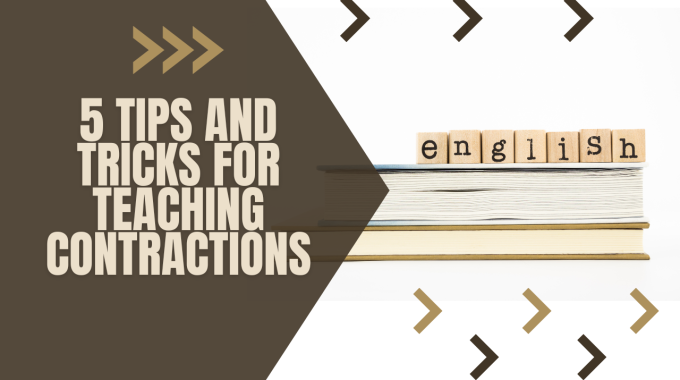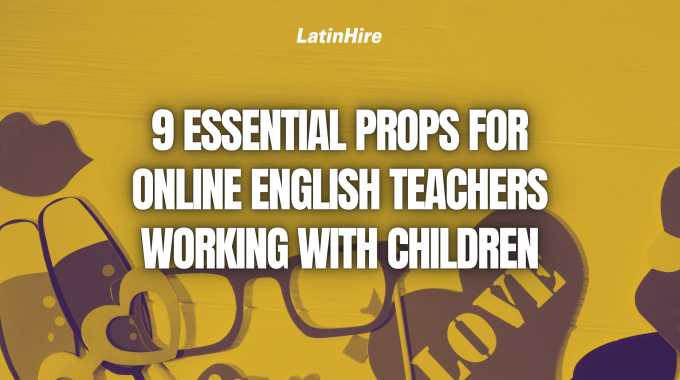Teaching English online to children is a lot more hands-on than teaching adults. It requires…

5 Tips and Tricks for Teaching Contractions
To contract means to make things shorter. So, contractions in English are shorter ways to write and say two words. There are over 90 contractions in the English language and they are more frequently used in speaking and informal writing.
Here are 5 tips and tricks for teaching contractions to your English students!
1. Teach your students that the apostrophe always replaces the missing letter(s).
Students often place the apostrophe at the wrong location because they try to learn contractions through memorization. However, if you teach your students that the apostrophe always replaces the missing letters, it’s a lot easier to remember.

Here are some examples:
I am = I’m (missing a)
You are = You’re (missing a)
He is = He’s (missing i)
Use the following activities to help your students learn contractions in a fun and engaging way.
2. Have your students do “contraction surgery”.
Print out a bunch of word pairs that can form contractions and have students cut out the unnecessary letters and “sew” the rest together with an apostrophe. For example, students can get slips of papers with word pairs, such as “ you are”, then they need to cut out the “a” and put an apostrophe in its place.
You can add your own spin on this activity, but using hands-on exercises like this can help students retain what they learn a lot faster.
3. Have students READ a text and find the contractions OR Have students CHANGE words in a text into contractions.

Print out a short piece of text, dialogue or song lyrics with many contractions and ask your students to highlight, underline or circle the contractions they find. You can turn this into a competition and see who can find the most contractions within a period of time.
Another exercise can be to present to your students a text without contractions and they have to identify all the places where a contraction can be used. Ask your students to cross out the word pairs that can be contracted and replace them with contractions.
4. Have students LISTEN and record all the contractions they hear.

Train your students’ ear to listen out for contractions by reading a text to them, playing an audio of a dialogue or a song and have them record all the contractions they hear. You can start with an easier warm up of this activity by reading out different contractions and having your students write them down, similar to a spelling bee.
5. Have students compete by converting word pairs into contractions or vice versa.
Write a list of word pairs in the middle of the whiteboard and divide the students into teams (or it can be a 1-1 competition). In the middle of the board will be a column of word pairs that can form contractions and on each side of the whiteboard one team will be responsible for converting those word pairs into contractions.
If this is an in-person class, students on the same team can form a line and do this in a relay style. If this is an online class, you can have students type out their responses in the Chat Box or write directly on the Zoom Whiteboard!
You can also do this activity in reverse. Put the contractions on the whiteboard and then have students split up the contractions into two words.
Here are some common contractions you can share with your students with examples!
Positive Contractions with Personal Pronouns
I am → I’m (I’m very happy today.)
I will → I’ll (I’ll go to a party tonight.)
I had → I’d (I’d better get started on that project.)
I would → I’d (I’d like to order a Coke.)
I have → I’ve (I’ve lived here for four years.)
You are → You’re (You’re the smartest person in the room.)
You will → You’ll (You’ll be doing your test tomorrow.)
You had → You’d (You’d gone before she arrived.)
You would → You’d (You’d really do that?)
You have → You’ve (You’ve gained weight.)
(Same for “we” and “they”)
He is → He’s (He’s fishing at the river.)
He will → He’ll (He’ll be here in five minutes.)
He had → He’d (He’d brushed his teeth before going to bed.)
He would → He’d (He’d prefer to take the exam next month.)
(Same for “she” and “it”)
Negative Contractions
are not → aren’t (The students aren’t happy with the increased amount of homework.)
can not → can’t (I can’t believe that happened!)
could not → couldn’t (She couldn’t make it to the conference.)
did not → didn’t (You didn’t complete the assignment.)
does not → doesn’t (He doesn’t want to visit the doctor.)
do not → don’t (We don’t think it’s a good idea to go for a picnic tomorrow.)
had not → hadn’t (They hadn’t thought of that idea.)
has not → hasn’t (She hasn’t gone grocery shopping yet.)
is not → isn’t (It isn’t raining right now.)
must not → mustn’t (You mustn’t forget your passport!)
need not → needn’t (He needn’t be so rude.)
should not → shouldn’t (I shouldn’t eat so much chocolate.)
was not → wasn’t (She wasn’t at the meeting.)
were not → weren’t (They weren’t eager to leave.)
will not → won’t (Why won’t you be there?)
would not → wouldn’t (I wouldn’t do that if I were you.)
Which of these tips and tricks would you like to try in your language class? Let us know in the comments below if you have other ideas for teaching contractions to your English students!



